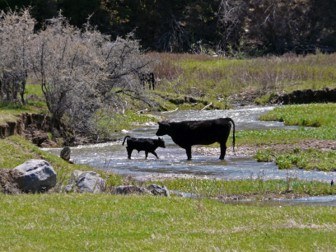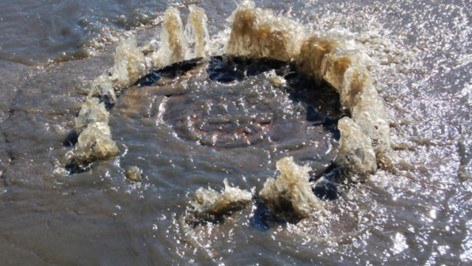Pathogens

Pathogens are disease-causing bacteria, viruses, or other microorganisms that can create health risks for people enjoying recreation in and on the water. Pathogens are generally carried to our estuarine waters by stormwater runoff from different sources, including:
- Inadequately treated sewage,
- Runoff from urban areas or animal (e.g., swine, cattle, and poultry) operations,
- Medical waste,
- Boat and marine waste,
- Combined sanitary sewer overflows (SSOs), or
- Waste from pets and wildlife (e.g., deer, geese, and racoons).
This ecosystem stressor is identified as a priority across many coastal Alabama’s watershed management plans, and direct testing for the presence pathogens is very expensive and impractical. Instead, when monitoring for pathogens, we use “indicator species,” so called because their presence indicates that fecal contamination may have occurred. The four indicators most commonly used today by both volunteer and professional water quality monitors – total coliforms, fecal coliforms, Escherichia coli, and enterococci. These bacteria are normally prevalent in the intestines and feces of birds and mammals and are themselves are not necessarily pathogenic.
Bacterial Source Tracking. Part of interpreting fecal coliform data involves trying to understand the sources of bacteria in our estuaries. If monitoring indicates high counts of bacteria, the next step is to determine possible sources. Bacterial source tracking involves different strategies. Monitors might first not the number of wildfowl in an area and scat (bird waste) along the shore. If wildlife are suspected sources, bacterial concentrations in an area with few signs of wildlife can be compared to those from an area heavily populated with wildlife. Screening parts of the watershed have residential areas where dog dropping are regularly found. It’s important to look preliminarily at all possible sources of bacteria before assuming that faulty sewage treatments or failing septic systems underlie the problem.
Other more complex (and expensive) methods are used by laboratories to track bacterial sources. One method uses the fact that some bacterial and humans and domesticated animals have developed resistance to antibiotics. Colonies of bacterial are exposed to various antibiotics to help determine whether the source of bacteria is human, domesticated animals, or wildlife. Polymerase chain reaction (PCR) analyses provide the most sensitive of existing rapid methods to source and discriminate between bacterial pathogens identified in water samples.
West Fowl River Watershed. Pathogens are a particular concern along the northern shore of Mississippi Sound, which is favored for off-bottom oyster aquaculture operations. In West Fowl River and Portersville Bay, levels of enterococci bacteria were low enough to meet ADEM’s standards for bodily contact and the promotion of fishing. However, in Fowl River Bay fecal coliform bacteria exceed the shellfish harvesting criteria of 14 most probably number / 100 ml so often that Fowl River Bay is classified as Conditionally Restricted for shellfish harvesting, meaning shellfish must be relayed to other water bodies before they can be brought to market.
In July 2017 and May 2018, Dauphin Island Sea Lab investigators and U.S. Food and Drug Administration staff investigated pathogen contamination throughout the Fowl River Watershed and Fowl River Bay to link bacterial sources with potential land used types. They sampled fecal coliform bacteria, as well as isotopes of carbon and nitrogen (as an indicator of potential sources, such as sewage. Highlights of their findings include the following:
- Highest abundances of fecal coliform bacteria were from the river, indicating watershed activities were likely the most important source of bacteria to the Bay.
- Lowest levels of fecal coliform bacteria were found at the outfall of the City of Bayou La Batre’s wastewater treatment plant, indicating the plant is not a significant source of bacteria to the Bay.
- Carbon and nitrogen isotope values suggested human activities likely increased fecal coliform loads from the watershed, in particular untreated sewage the could be coming from failing septic tanks systems.
- Fecal coliform bacteria were elevated in areas close to both cattle grazing sites and bird rooting sites, but concentrations rapidly diminished with distance from these sources, suggesting some combination of die-off and mixing might moderate their influence.
- Samples taken close to cattle grazing sites had high levels of fecal coliform bacteria than those taken close to bird roosting sites, but with samples collected only one day, the significance of this result is severely limited.
The results of the DISL/FDA efforts support the contention that the Watershed is the dominant source of fecal coliform bacteria in Fowl River Bay, as opposed to in-water sources such as bird roosting sites. However, the interpretation of results focused on cattle grazing and bird roosting is compromised by only single days’ worth of data. Overall results suggest human activities on the watershed are likely increasing the load of bacteria into Fowl River Bay and increased rainfall on the Watershed would likely cause increased bacteria levels in the Bay. The finding that rainfall appears to be trending towards higher levels over the past few years suggests the issue of fecal coliform bacteria in Fowl River Bay may not improve over time.

Weeks Bay Watershed Complex. The 203-square mile Weeks Bay Watershed Complex includes the Upper Fish River, Middle Fish River, Lower Fish River, and Magnolia River watersheds and stretches 27 miles from near Stapleton south to Weeks Bay. A Weeks Bay Watershed Management Plan was published in November 2017. Land uses include increasing urbanization around the Watershed perimeter and pervasive historical and ongoing agricultural activities, including row crops and cattle grazing, but uplands in the watershed are primarily evergreen, mixed, and deciduous forests. It is evident that pathogen levels frequently exceed ADEM standards, particularly following rain events. ADEM has developed pathogen Total Maximum Daily loads, calling for a 68% load reduction from nonpoint sources in the Watershed Complex. To date, efforts to identify pathogen sources (whether human, wildlife, or livestock) using antibiotic resistance analysis and PCR analyses have been inconclusive, and additional efforts will be necessary to develop detailed management measures to achieve the ADEM-recommended reductions (Upper Fish River Bacterial Source Tracing Project October 2008 – March 2011). Conclusions from both source tracking methods indicated that humans, cattle, and horses remained serious potential pathogen sources in the Upper Fish River Watershed. Human and horse sources seem a more significant threat following rainfall events. Cost and time involved in analysis of wildlife sources precluded determination of its contribution to Upper Fish River pathogen contamination.
Three Mile Creek Watershed. The Three Mile Creek Watershed Management Plan, published in September 2014, describes ecological challenges related to stormwater and wastewater as sources of pathogen pollution in the Creek. With only an ADEM use designation of Agricultural and Industrial Water Supply (and the most relaxed water quality standards) Three Mile Creek (TMC) was first added to the States 303(d) List of Impaired Waterbodies over its entire extent for pathogen exceedances in 1996, with municipal and storm sewers indicated as sources. In 2004, two TMC tributaries – Toulmins Spring Branch and an unnamed midtown tributary to TMC – were added to the 303(d) list for pathogens. In 2010, the upper reaches of TMC were delisted for pathogens, since monitoring did not reveal exceedances. Then, in 2010, with Total Maximum Daily Loads (TMDLs) developed for Toulmins Spring Branch and the unnamed tributary, both were delisted for pathogens. Implementation of the TMDLs is an ongoing effort, with pathogen exceedances continuing there.
Most all sources of pathogens into TMC are related to stormwater runoff. which carries pet waste off lawns into stormwater infrastructure and the Illicit or compromised connections between aging stormwater and wastewater infrastructure are overwhelmed during significant rain events, causing frequent sanitary sewer overflows (or SSOs). It also carries pet waste off lawns and swales directly into storm drains to be carried into the Creek.
In 2009, Mobile Area Water and Sewer System (MAWSS) undertook an illicit discharge study of the TMC stormwater system. Of several potential discharge locations traced and sampled, they removed two verified sanitary sewer discharged to stormwater outfalls. Point source discharges from the MAWSS Wright Smith Jr. Wastewater Treatment Facility (WWTF) and the Carlos A. Morris WWTF were removed from TMC (and routed into Mobile River) in 2014.
Currently, MAWSS is involved in multi-faceted efforts to reduce the incidences of SSOs spilling into TMC. These include:
- Construction of two new severe weather attenuation tanks (SWATS) adjacent to an existing eight-million gallon SWAT east of and close to Tricentennial Park to provide temporary side-stream storage capacity (an additional 20 million gallons) for waste water during heavy rain events. Upgrades will increase pumping capacity from 23 million gallons per day (g/d) to 52 million g/d.
- Replacement of approximately 11,000 linear feet of aging 42-inch to 48-inch sewage trunk lines with new 60-inch gravity sewer main. The new line will stretch from Mobile Street east to St. Stephens Road adding integrity to the sanitary sewer system and reducing occurrences of SSOs.




